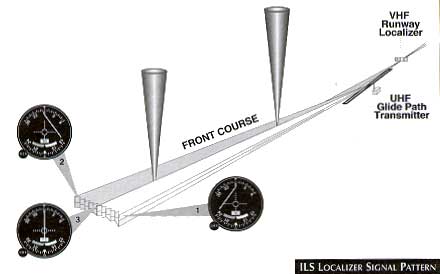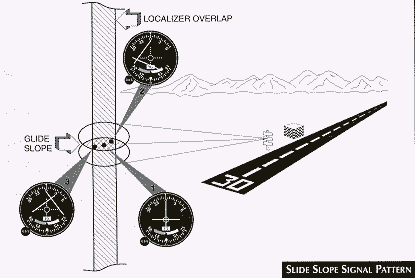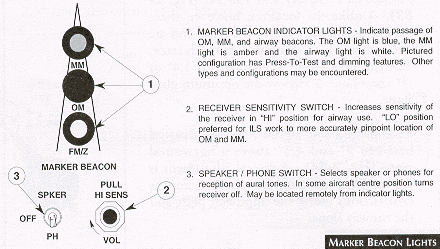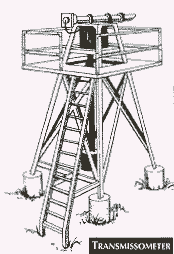 |
|||||
| Home | Research | For Teachers | HISTORY Level 1 Level 2 Level 3 |
PRINCIPLES Level 1 Level 2 Level 3 |
CAREER Level 1 Level 2 Level 3 |
| Gallery | Hot Links | What's New! | |||
| Web Administration and Tools | |||||
 |
|||||
| Home | Research | For Teachers | HISTORY Level 1 Level 2 Level 3 |
PRINCIPLES Level 1 Level 2 Level 3 |
CAREER Level 1 Level 2 Level 3 |
| Gallery | Hot Links | What's New! | |||
| Web Administration and Tools | |||||
Navigation Systems - Level 3
![]()
A. GENERAL DESCRIPTION
Instrument landing system (ILS) facilities are a highly accurate and dependable means of navigating to the runway in IFR conditions. When using the ILS, the pilot determines aircraft position primarily by reference to instruments. The ILS consists of:
ILS is classified by category in accordance with the capabilities of the ground equipment. Category I ILS provides guidance information down to a decision height (DH) of not less than 200 ft. Improved equipment (airborne and ground) provide for Category II ILS approaches.
A DH of not less than 100 ft. on the radar altimeter is authorized for Category II ILS approaches.
The ILS provides the lateral and vertical guidance necessary to fly a precision approach, where glide slope information is provided. A precision approach is an approved descent procedure using a navigation facility aligned with a runway where glide slope information is given. When all components of the ILS system are available, including the approved approach procedure, the pilot may execute a precision approach.
B. LOCALIZER
1. GROUND EQUIPMENT: The primary component of the ILS is the localizer, which provides lateral guidance. The localizer is a VHF radio transmitter and antenna system using the same general range as VOR transmitters (between 108.10 MHz and 111.95 MHz). Localizer frequencies, however, are only on odd-tenths, with 50 kHz spacing between each frequency. The transmitter and antenna are on the centerline at the opposite end of the runway from the approach threshold.
The localizer back course is used on some, but not all ILS systems. Where the back course is approved for landing purposes, it is generally provided with a 75 MHz back marker facility or NDB located 3 to 5 NM from touchdown. The course is checked periodically to ensure that it is positioned within specified tolerances.
2. SIGNAL TRANSMISSION: The signal transmitted by the localizer consists of two vertical fan-shaped patterns that overlap, at the center (see ILS Localizer Signal Pattern figure, below). They are aligned with the extended centerline of the runway. The right side of this pattern, as seen by an approaching aircraft, is modulated at 150 Hz and is called the "blue" area. The left side of the pattern is modulated at 90 Hz and is called the "yellow" area. The overlap between the two areas provides the on-track signal.
The width of the navigational beam may be varied from approximately 3º to 6º, with 5º being normal. It is adjusted to provide a track signal approximately 700 ft wide at the runway threshold. The width of the beam increases so that at 10 NM from the transmitter, the beam is approximately one mile wide.

The localizer is identified by an audio signal superimposed on the navigational signal. The audio signal is a two-letter identification preceded by the letter "I", e.g., " I-OW ".
The reception range of the localizer is at least 18 NM within 10º degrees of the on-track signal. In the area from l0º to 35º of the on-track signal, the reception range is at least 10 NM. This is because the primary strength of the signal is aligned with the runway centerline.
3. LOCALIZER RECEIVER: The localizer signal is received in the aircraft by a localizer receiver. The localizer receiver is combined with the VOR receiver in a single unit. The two receivers share some electronic circuits and also the same frequency selector, volume control, and ON-OFF control.
The localizer signal activates the vertical needle called the track bar (TB). Assuming a final approach track aligned north and south (see ILS Localizer Signal Pattern figure, above), an aircraft east of the extended centerline of the runway (position 1) is in the area modulated at 150 Hz. The TB is deflected to the left. Conversely, if the aircraft is in the area west of the runway centerline, the 90 Hz signal causes the TB to deflect to the right (position 2). In the overlap area, both signals apply a force to the needle, causing a partial deflection in the direction of the strongest signal. Thus, if an aircraft is approximately on the approach track bur slightly to the right, the TB is deflected slightly to the left. This indicates that a correction to the left is necessary to place the aircraft in precise alignment.
At the point where the 90 Hz and 150 Hz signals are of equal intensity, the TB is centered, indicating that the aircraft is located precisely on the approach track (position 3).
When the TB is used in conjunction with the VOR, full scale needle deflection occurs 10º either side of the track shown on the track selector. When this same needle is used as an ILS localizer indicator, full-scale needle deflection occurs at approximately 2.5º from the center of the localizer beam.
Thus the sensitivity of the TB is approximately four times greater when used as a localizer indicator as opposed to VOR navigation.
In the localizer function, the TB does not depend on a correct track selector setting in Most cases; however, the pilot should set the track selector for the approach track as a reminder of the final approach.
When an OFF flag appears in front of the vertical needle, it indicates that the signal is too weak, and, therefore, the needle indications arc unreliable. A momentary OFF flag, or brief TB needle deflections, or both, may occur when obstructions or other aircraft pass between the transmitting antenna and the receiving aircraft.
C. GLIDE SLOPE EQUIPMENT
1. TRANSMITTER: The glide slope provides vertical guidance to the pilot during the approach. The ILS glide slope is produced by a ground-based UHF radio transmitter and antenna system, operating at a range of 329.30 MHz to 335.00 MHz, with a 50 kHz spacing between each channel. The transmitter is located 750 to 1,250 feet (ft) down the runway from the threshold, offset 400 to 600 ft from the runway centerline. Monitored to a tolerance of ± 1/2 degree, the UHF glide path is "paired" with (and usually automatically tuned by selecting) a corresponding VHF localizer frequency.
Like the localizer, the glide slope signal consists of two overlapping beams modulated at 90 Hz and 150 Hz (see Glide Slope Signal Pattern figure, below). Unlike the localizer, however, these signals are aligned above each other and are radiated primarily along the approach track. The thickness of the overlap area is 1.4º or .7º above and .7º below the optimum glide slope.

This glide slope signal may be adjusted between 2º and 4.5º above a horizontal plane. A typical. adjustment is 2.5º to 3º, depending upon such factors as obstructions along the approach path and the runway slope.
False signals may be generated along the glide slope in multiples of the glide path angle, the first being approximately 6º degrees above horizontal. This false signal will be a reciprocal signal (i.e. the fly up and fly down commands will be reversed). The false signal at 9º will be oriented in the same manner as the true glide slope. There are no false signals below the actual slope. An aircraft flying according to the published approach procedure on a front course ILS should not encounter these false signals.
2. SIGNAL RECEIVER: The glide slope signal is received by a UHF receiver in the aircraft. In modern avionics installations, the controls for this radio are integrated with the VOR controls so that the proper glide slope frequency is tuned automatically when the localizer frequency is selected.
The glide slope signal activates the glide slope needle, located in conjunction with the TB (see Glide Slope Signal Pattern figure, above). There is a separate OFF flag in the navigation indicator for the glide slope needle. This flag appears when the glide slope signal is too weak. As happens with the localizer, the glide slope needle shows full deflection until the aircraft reaches the point of signal overlap. At this time, the needle shows a partial deflection in the direction of the strongest signal. When both signals are equal, the needle centers horizontally, indicating that the aircraft is precisely on the glide path.
The pilot may determine precise location with respect to the approach path by referring to a single instrument because the navigation indicator provides both vertical and lateral guidance. In the Glide Slope Signal Pattern figure, above, position 1, shows both needles centered, indicating that the aircraft is located in the center of the approach path. The indication at position 2 tells the pilot to fly down and left to correct the approach path. Position 3 shows the requirements to fly up and right to reach the proper path. With 1.4º of beam overlap, the area is approximately 1,500 ft thick at 10 nautical miles (NM), 150 ft at l NM, and less than one foot at touchdown.
The apparent sensitivity of the instrument increases as the aircraft nears the runway. The pilot must monitor it carefully to keep the needle centered. As said before, a full deflection of the needle indicates that the aircraft is either high or low but there is no indication of how high or low.
D. ILS MARKER BEACONS
l . GENERAL: Instrument landing system marker beacons provide information on distance from the runway by identifying predetermined points along the approach track. These beacons are low-power transmitters; that operate at a frequency of 75 MHz with 3 W or less rated power output. They radiate an elliptical beam upward from the ground. At an altitude of 1,000 ft, the beam dimensions are 2,400 ft long and 4,200 ft wide. At higher altitudes, the dimensions increase significantly.
 2. OUTER MARKER (OM): The outer marker (if installed) is located 3
1/2 to 6 NM from the threshold within 250 ft of the extended runway centerline. It
intersects the glide slope vertically at approximately 1,400 ft above runway elevation. It
also marks the approximate point at which aircraft normally intercept the glide slope, and
designates the beginning of the final approach segment. The signal is modulated at 400 Hz,
which is an audible low tone with continuous Morse code dashes at a rate of two dashes per
second. The signal is received in the aircraft by a 75 MHz marker beacon receiver. The
pilot bears a tone over the speaker or headset and sees a blue light that flashes in
synchronization with the aural tone (see the Marker Beacon
Lights figure, above right). Where geographic conditions prevent
the positioning of an outer marker, a DME unit may be included as part of the ILS system
to provide the pilot with the ability to make a positive position fix on the localizer. In
most ILS installations, the OM is replaced by an NDB.
2. OUTER MARKER (OM): The outer marker (if installed) is located 3
1/2 to 6 NM from the threshold within 250 ft of the extended runway centerline. It
intersects the glide slope vertically at approximately 1,400 ft above runway elevation. It
also marks the approximate point at which aircraft normally intercept the glide slope, and
designates the beginning of the final approach segment. The signal is modulated at 400 Hz,
which is an audible low tone with continuous Morse code dashes at a rate of two dashes per
second. The signal is received in the aircraft by a 75 MHz marker beacon receiver. The
pilot bears a tone over the speaker or headset and sees a blue light that flashes in
synchronization with the aural tone (see the Marker Beacon
Lights figure, above right). Where geographic conditions prevent
the positioning of an outer marker, a DME unit may be included as part of the ILS system
to provide the pilot with the ability to make a positive position fix on the localizer. In
most ILS installations, the OM is replaced by an NDB.
3. MIDDLE MARKER (MM): Middle markers have been removed from all ILS facilities in Canada bur are still used in the United States. The middle marker is located. approximately .5 to .8 NM from the threshold on the extended
runway centerline. The middle marker crosses the glide slope at approximately 200 to 250 ft above the runway elevation and. is near the missed approach point for the ILS Category l approach.
4. BACK MARKER (BM): The back course marker (BM), if installed, is normally located on the localizer back course approximately four to six miles from the runway threshold. The BM low pitched tone (400 Hz) is beard as a series of dots. It illuminates the aircraft's white marker beacon light. An NDB or DME fix can also be used and in most locations replace the BM.
E. LIGHTNING SYSTEMS
1. GENERAL: Various runway environment lighting systems serve as integral parts of the ILS system to aid the pilot in landing. Any or all of the following lighting systems may be provided at a given facility: approach light system (ALS), sequenced flashing light (SFL), touchdown zone lights (TDZ) and centerline lights (CLL-required for Category II [Cat II] operations.)
2. RUNAWAY VISIBILITY MEASUREMENT: In order to land, the pilot must be able to see appropriate visual aids not later than the arrival at the decision height (DH) or the missed approach point (MAP).
Until fairly recently, the weather observer simply "peered into the murk",
trying to identify landmarks at known distances from the observation point. This method is
rather inaccurate; therefore, instrumentation was developed to improve the observer's
capability.
The instrument designed to provide visibility information is called a transmissometer. It is normally located adjacent to a runway. The light source (see the Transmissometer figure, on the right) is separated from the photo-electric cell receiver by 500 to, 700 ft. The receiver, connected to the instrument readout in the airport tower, senses the reduction in the light level between it and the light source caused by increasing amounts of particulate matter in the air. In this way the receiver measures the relative transparency or opacity of the air. The readout is calibrated in feet of visibility and is called runway visual range (RVR).
3. RUNAWAY VISUAL RANGE (RVR): The RVR is the maximum distance in the direction of take-off or landing at which the runway or the specified light or markers delineating it can be seen from a height corresponding to the average eye-level of pilots at touchdown.
Runway visual range readings usually are expressed in hundreds of feet. For example, "RVR 24" means that the visual range along the runway is 2,400 ft. In weather reports, RVR is reported in a code: R36/4000 FT/D; meaning RVR for Runway 36 is 4000 ft and decreasing. Because visibility may differ from one runway to another, the RVR value is always given for the runway where the equipment is located. At times, visibility may even vary at different points along the same runway due to a local condition such as a fog bank, smoke, or a line of precipitation. For this reason, additional equipment may be installed for the departure end and mid-point of a runway.
Runway visual range reports are intended to indicate bow far the pilot can see along the runway in the touchdown zone; however, the actual visibility at other points along the runway may differ due to the siting of the transmissometer. The pilot should take this into, account when making decisions based on reported RVR.
Runway visual range is not reported unless the prevailing visibility is less than two miles or the RVR is 6,000 ft or less. This is so because the equipment cannot measure RVR above 6,000 ft. When it is reported, RVR can be used as an aid to pilots in determining what to expect during the final stages of an instrument approach. Instrument approach charts state the advisory values of visibility and RVR.
Runway visual range information is provided to the ATC arrival control. sector, the PAR position, and the control tower or FSS. It is passed routinely to the pilot when conditions warrant. RVR information may be included in aviation weather reports.
Ground visibility will continue to be reported and used in the application of take-off and landing minima. At runways with a transmissometer and digital readout equipment or other suitable means, RVR is used in lieu of prevailing visibility in determining the visibility minima unless affected by a local weather phenomenon of short duration.
The normal RVR reading is based on a runway light setting of strength 3. If the light settings are increased to strength 4 or 5, it causes a relative increase in the RVR reading. No decrease in the RVR reading is evident for light settings of less than setting 3. Pilots shall be advised when the runway light setting is adjusted to 4 or 5. If the RVR for a runway is measured at two locations, the controller identifies the touchdown location as "ALFA and the mid runway location as "Bravo".
In all cases, the pilot can request a light setting suitable for his or her requirements. When more than one aircraft is conducting an approach, the pilot of the second aircraft may request a change in the light setting after the first aircraft has completed its landing.
Because of the complex equipment requirements, RVR usually is only available at more active airports and not necessarily for all runways. If RVR equipment is not available or temporarily out of service for a given runway, the pilot uses the observer method to provide visibility information. In this case, the visibility is expressed as miles or fractions of a mile. The relationship between RVR values and visibility is shown below.
F. NDBs AT MARKER BEACON SITES
Additional aids may be available to assist the pilot in reaching the final approach fix. One of these aids is the NDB which can be co-located with or replace the outer marker (OM) or back marker (BM). It is a low-frequency non-directional beacon with a transmitting power of less than 25 watts (W) and a frequency range of 200 kilohertz (kHz) to 415 kHz. The reception range of the radio beacon is at least 15 nautical miles (NM). In a number of cases an en route NDB is purposely located at the outer marker so that it may serve as a terminal as well as an en route facility.
Send all comments to ![]() aeromaster@eng.fiu.edu
aeromaster@eng.fiu.edu
© 1995-98 ALLSTAR Network. All rights reserved worldwide.
Updated: February 23, 1999